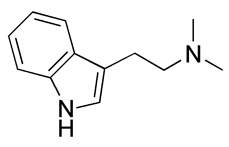Dimethyltryptamine
Dimethyltryptamine, also known as DMT and N,N-dimethyltryptamine, not to be confused with 5-MeO-DMT, is a hallucinogenic tryptamine, similar in structure to the neurotransmitter serotonin. DMT is created in small amounts by the human body during normal metabolism. Pure DMT at room temperature is a colorless waxy or crystalline solid. DMT was first chemically synthesized in 1931. It also occurs naturally in many species of plants. DMT-containing plants are used in several South American shamanic practices. more...
It is one of the main active constituents of snuffs like yopo and of the drink ayahuasca.
DMT is not orally active unless it is combined with a monoamine oxidase inhibitor (MAOI), such as harmaline. Without an MAOI, the body quickly metabolizes DMT, and it therefore has no significant hallucinogenic effect.
Hallucinogenic properties
DMT is a powerful psychoactive substance. If DMT is smoked, injected, or orally ingested with an MAOI, it can produce powerful entheogenic experiences including true hallucinations (perceived extensions of reality). A trip sitter is often employed to assist the drug user in staying physically and mentally healthy, and, in the case of smoked DMT, to catch the pipe when the user loses awareness of it.
Smoked: If DMT is smoked, the maximal effects last for a short period of time (30 minutes +). The onset after inhalation is very fast (less than 45 seconds) and maximal effects are reached within about a minute.
Insufflation: If DMT is insufflated (snorted through the nostrils) it will last slightly longer than if smoked and has less powerful effects.
Injection: Injected DMT produces an experience similar to inhalation in duration, intensity, and characteristics, although by some accounts it is more emotionally clinical (versus spiritual).
Oral ingestion: DMT, which is broken down by the digestive enzyme monoamine oxidase, is inactive if taken orally, unless combined with a monoamine oxidase inhibitor (MAOI). The shamanic potion ayahuasca, or yage, is a tea-like admixture of the boiled leaves, bark or roots of a variety of plants, usually including Psychotria viridis, which contains high levels of DMT, and Banisteriopsis caapi, which contains harmala alkaloids that are powerful MAOIs. A common source in the western US is Reed canary grass or Phalaris arundinacea, and Harding grass or Phalaris aquatica. This invasive grass contains high levels of DMT and other alkaloids . Taken orally with an appropriate MAOI, DMT produces a long lasting (over 1 hour), slow onset, high intensity experience. MAOIs should be used with extreme caution as they can make common over-the-counter drugs and foods toxic.
Induced DMT experiences can include profound time-dilation, visual and audio hallucinations, percieved journeys to paranormal realms, and encounters with spiritual beings or other experiences that, by most first hand accounts, defy verbal or visual description.
In a 1988 study conducted at UNM, psychiatrist Rick Strassman found that approximately 20% of volunteers injected with high doses of DMT had experiences identical to purported alien abductions.
Read more at Wikipedia.org



